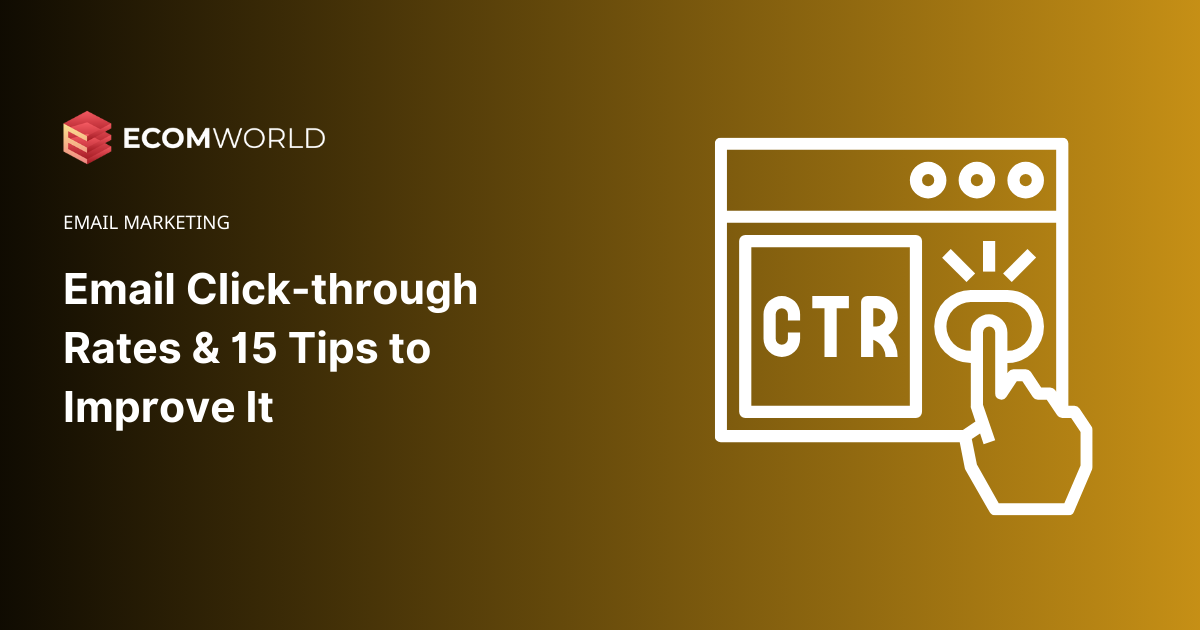As a novice in email marketing, you must take pride in launching your inaugural email campaign. When you observe a significant email open rate, it fills you with satisfaction and high hopes for a lucrative return on investment. However, when this doesn’t materialize, frustration sets in.
Why is your campaign falling short of its objectives? Why do people open your emails, yet the conversion rate remains disappointingly low? These are likely the questions that cross your mind, and a plausible explanation could be a low click-through rate.
The click-through rate holds immense importance in the realm of email marketing metrics. Without knowing how many individuals are clicking the links within your emails, it becomes challenging to gauge how well your emails are being received and the extent to which they compel individuals to join your email list. A click-through rate exceeding 2% is generally considered a favorable benchmark (according to Wordstream). Consequently, this is the target email marketers should strive to attain.
However, there’s no need for concern! This blog is dedicated to guiding you on how to boost your email click-through rate by incorporating industry best practices into your email marketing campaigns.
Table of Contents
Email Click-through Rate – Definition
Email click-through rate (CTR) serves as a measurement indicating how frequently recipients of your emails engage by clicking on at least one link within the email. A substantial CTR signifies that individuals perceive your email content as pertinent and are motivated to click through for further exploration.
However, it’s important to note that click-through rates encompass two distinct categories:
- Total click-through rate (TCTR)
- Unique click-through rate (UCTR)
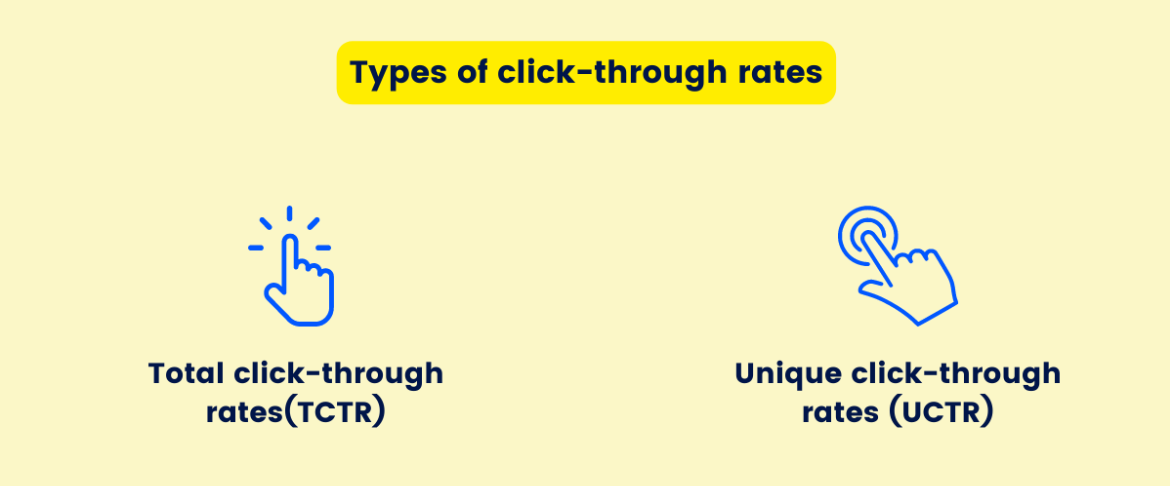
Total click-through rate (TCTR)
The total click-through rate (TCTR) quantifies the overall number of clicks an email garners. It reflects the email’s general popularity, although there are certain factors that can introduce some variability into TCTR, rendering it a non-standard measure for email click-through evaluation. These factors encompass:
- Individuals accessing email links on multiple devices.
- Repeatedly clicking on the same links.
- Firewalls automatically open links to conduct malware scans.
For instance, if you click on an email link both from a computer and a phone, the TCTR will record two separate clicks. Similarly, if you open the same link in the morning and then again at night, the TCTR will register it as two clicks instead of just one.
Firewalls can also contribute to TCTR when they initiate link openings to examine potential malware threats. However, clicks generated by firewalls are not of organic origin, making it challenging to ascertain their uniqueness.
Unique click-through rate (UCTR)
The unique click-through rate (UCTR) is a metric that quantifies the distinct clicks received by an email link. In contrast to the total click-through rate (TCTR), UCTR treats each click as unique. Thus, if you happen to open a link several times, perhaps to share it with friends, UCTR records it as a single unique click rather than multiple identical clicks.
Both UCTR and TCTR hold significance but serve different purposes. TCTR is valuable when you seek a comprehensive overview of the overall sharing and repeated interaction with your emails. On the other hand, if you aim to determine the proportion of individual, non-repetitive clicks, then UCTR is the preferred metric to utilize.
Why are click-through rates important?
Click-through rates hold significant importance as they serve as a reflection of engagement with your email content. The greater the number of individuals who click through to your website or landing page, the higher the likelihood of achieving your email marketing objectives.
Additionally, click-through rates play a crucial role in gauging customer expectations. They offer valuable insights to email marketers regarding whether they are effectively reaching the appropriate audience through their email campaigns.
Consider a scenario involving a blog dedicated to reviewing mobile phones and discussing their new features. If you send emails to a recipient list that lacks interest in topics such as the best budget mobile phones on the market or the most feature-rich mobile devices, your email click-through rate and open rate will likely suffer as a consequence. Consequently, this can lead to a decrease in conversions and leads.
However, there is a positive aspect to this situation as well. By closely monitoring your click-through rate, you can discern which individuals within your email list possess a genuine interest in reading your blog.
How to Calculate Email CTR?
The email click-through rate (CTR) is determined by dividing the count of individuals who clicked on a link within your email by the total number of recipients who received the email. For instance, if your email is sent to 1,000 people and 100 of them click on a link, your email CTR would be 10%. In this way, the formula for calculating CTR can be expressed as follows:
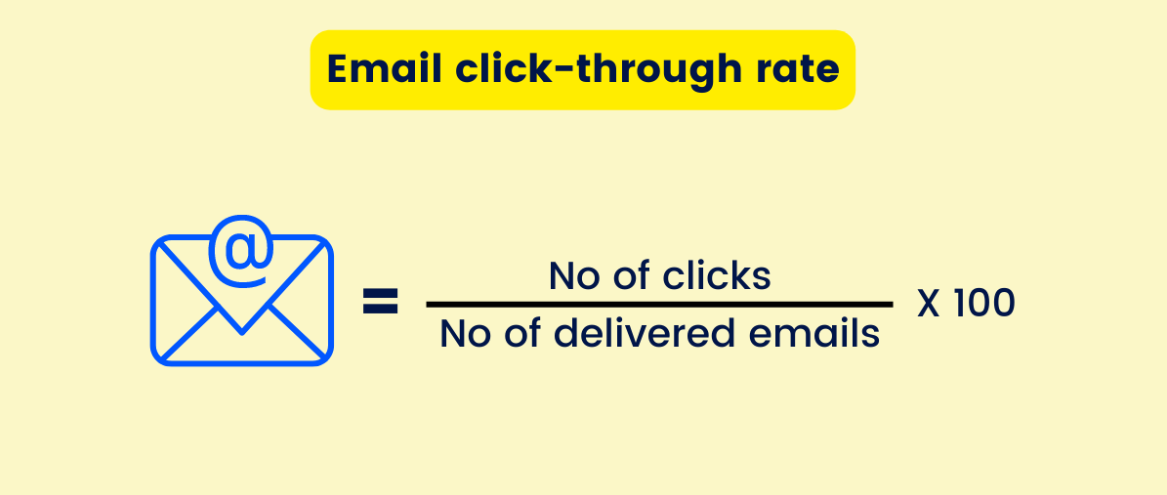
3 Factors affecting email CTR rates
Numerous elements influence email CTR rates, encompassing aspects such as the email subject line, email content, the call to action, bounce rate, and the recipient’s email client.
- Subject Lines: If a subject line contains phrases like “100 percent guaranteed,” “amazing offer,” or “best price,” it will be flagged as spam by Email Service Providers (ESPs). Consequently, it can trigger the spam filter, leading the email to be relegated to the spam folder. Additionally, the use of capitalized BLOCK letters in subject lines is discouraged as it can also trigger spam filters and potentially result in ESP blacklisting if this practice persists.
- CTA Placement: The click-through rate (CTR) of an email can suffer if the email content doesn’t align with the recipient’s interests. When the call to action (CTA) is not readily visible to the recipient, they may not click through to your websites or landing pages. Typically, it’s advisable to include one CTA, either in the middle of the email copy or at its conclusion. However, on occasion, some email marketers choose to incorporate two CTAs—one in the banner and another at the end of the email copy.
- Bounce Rate: The bounce rate indicates the percentage of website visitors who depart without taking any action, such as clicking on a link, completing a form, or making a purchase. It’s important to note that not all bounce rates are equal, and there are two distinct types:
Hard Bounce: Hard bounces occur when an email is sent to an invalid email address. These instances can substantially impact email deliverability and sender reputation scores.
Soft Bounce: Soft bounces take place when an email is sent to a valid email address but is returned by the email server.
Both types of bounce rates can influence your email CTR, but hard bounces have a more pronounced effect as they prevent the email from being successfully delivered.
What is a good email CTR rate?
There isn’t a universally accepted benchmark for what constitutes a favorable email CTR rate. Various factors come into play when determining CTR, including your specific goals and aims for your email marketing endeavors.
However, when looking at averages across diverse industries, the typical CTR rate stands at 2.60%. It’s worth noting that government emails tend to exhibit the highest CTR rate, reaching 6.00%, whereas retail businesses often experience a notably lower CTR rate, hovering at just 1.10%.
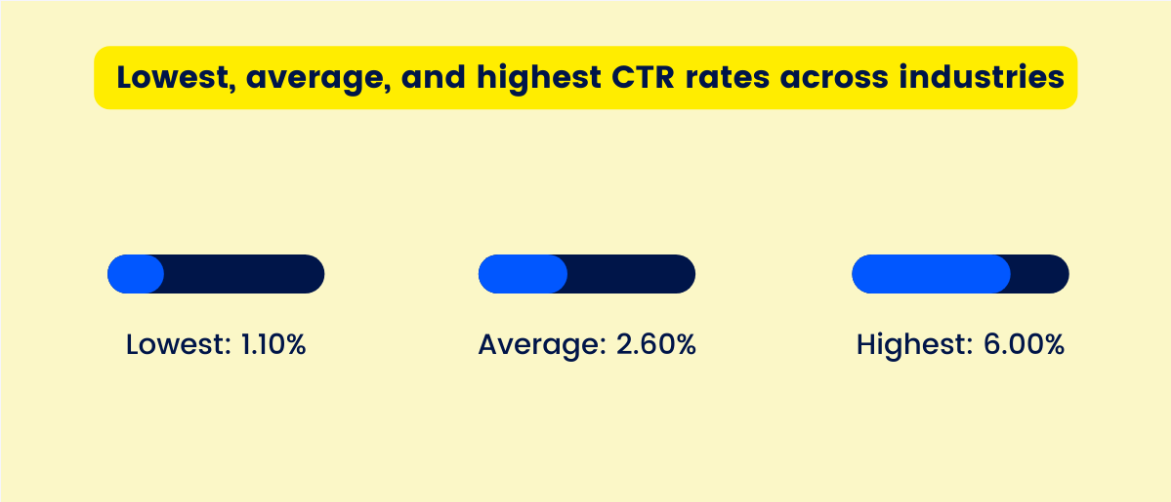
How do click-through rates compare by device?
Your choice of email client can also impact your email CTR rates. In general, mobile devices tend to yield lower CTR rates compared to desktop computers. People often skim through emails on their mobile devices and are less inclined to click through to a website or landing page.
For instance, when it comes to keywords ranking at the #1 position in Google search results, desktops exhibit a CTR of 27.09%, whereas mobile devices display a slightly lower CTR of 20.96%.
However, it’s noteworthy that 80% of brands craft emails optimized for mobile phones, and such tailored emails generate a 15% boost in CTR rates compared to unoptimized counterparts. Hence, it’s essential not to overlook mobile device users when launching your email marketing campaigns.
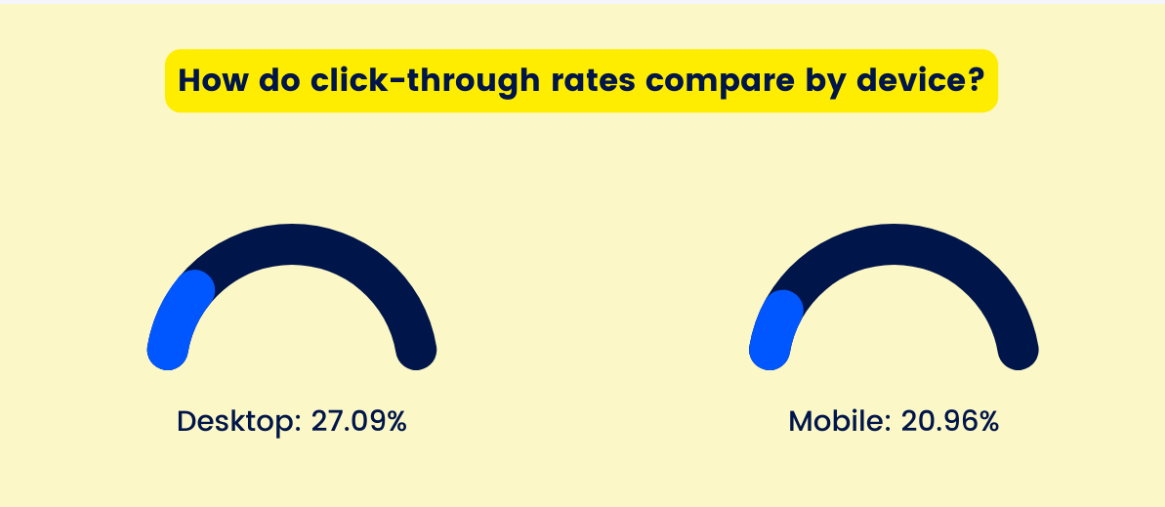
How to improve an email’s CTR — 15 Effective tips
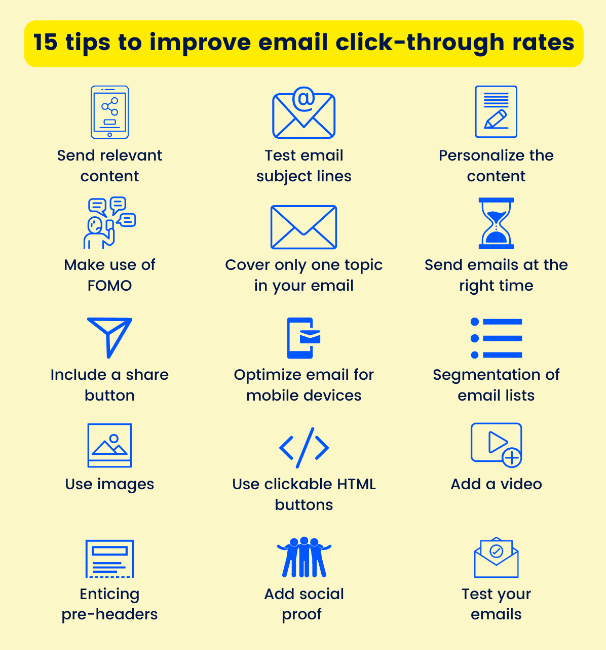
Send relevant content
Enhancing your email CTR rates hinges on offering content tailored to a specific audience, providing something of value. Additionally, incentivizing recipients to click links can boost CTR rates. These incentives may be integrated into the email copy, accompanied by visually guided elements such as images.
Test email subject lines
An astounding 69% of recipients will mark an email as spam if they deem the subject line unenticing. The subject line is the initial point of contact, making its effectiveness paramount. Experimenting with various subject lines through A/B testing can reveal which ones garner the most opens and clicks. Personalized subject lines typically lead to a higher open rate of approximately 22% compared to non-personalized ones.
Personalize the content
Ensure email content is personalized for each recipient, including their name and content relevant to their interests. Embrace a conversational tone to foster a more comfortable communication environment. Personalized emails typically yield a click-through rate 2.5 times higher than non-personalized ones and generate 5.7 times more revenue.
Make it easy to unsubscribe
Counterintuitively, facilitating easy email unsubscription can enhance email CTR. When recipients perceive it’s straightforward to opt out of your email list, they tend to trust you more and are more likely to click on the email’s links. It’s advisable to include an unsubscribe button that’s easily visible to the recipient.
Make use of FOMO
People tend to be more inclined to act when they sense they might miss out on an opportunity. Employ email marketing tactics that instill a sense of urgency, like presenting time-limited discounts or providing early access to a new product.
Additionally, offering special incentives to first-time customers can tap into the natural human inclination towards limited and exclusive offerings. As a result, experienced email marketers leverage this approach to increase both click-through rates and conversion rates.
Cover only one topic in your email
Maintain a single-topic focus in your emails to prevent distractions that might lead people to click away. If you have multiple subjects to address, consider sending separate emails for each one. Avoid creating confusion by refraining from presenting numerous deals and offers simultaneously. Concentrate on the current marketing campaign and ensure that the emails feature images relevant to that specific topic.
Optimize emails for mobile devices
An increasing number of individuals are accessing emails via their mobile devices, with 85% of email users now checking their emails on mobiles. Consequently, it’s crucial to ensure your emails are optimized for this audience. Ensure that the text is legible and the links are easily clickable when viewed on mobile screens.
Additionally, optimize the images to be compatible with older versions of mobile devices. This approach expands the reach and effectiveness of your email marketing campaigns.
Send emails at the right time
Timing plays a pivotal role in email marketing success. Ensure that your emails are dispatched when recipients are most likely to read and engage with them. Sending emails during working hours, particularly at 1 PM, has been observed to yield a click-to-open rate of 22%. Additionally, sending emails at midnight (12 AM) can also be effective.
Emails sent at the beginning and end of the day align with the times when people typically check their inboxes, making it a prudent strategy to schedule emails during these periods.
Furthermore, it is advisable to target your email dispatches for Tuesday, Wednesday, and Thursday, as these days tend to exhibit the highest open and click-through rates.
Include a share button
Facilitate effortless sharing of your email by incorporating a dedicated share button. This feature enables recipients to easily disseminate your email within their social networks, potentially boosting your CTR. Ensure that these buttons are branded for popular platforms such as Facebook, LinkedIn, Twitter, and Instagram.
Research has indicated that the inclusion of a social media share button can elevate click-through rates by 30%. Furthermore, when three or more share buttons are included, the CTR rate can surge to an impressive 55%.
A notable example of effective implementation can be seen in Bed, Bath, and Beyond’s emails, where they prominently feature their social media buttons. In the center of the image, they display icons representing the various social media platforms they are active on. At the bottom of the email, clickable buttons for Facebook, Pinterest, YouTube, and Twitter are thoughtfully included.
Segmentation of email lists
A method for enhancing email CTR involves dividing your email list into segments. This entails dispatching distinct emails to diverse groups predicated on their interests or demographic characteristics. Research has revealed that email marketers who implement this segmentation practice have witnessed a remarkable 760% upsurge in their revenue.
Consequently, it becomes crucial to ensure that your email campaigns are precisely tailored to the appropriate recipients. To achieve this, consider purging your email lists of inactive subscribers and periodically assessing the latest click-through rates to discern which subscribers exhibit genuine interest in receiving your emails.
Use clickable HTML buttons
HTML buttons tend to garner more clicks compared to text links, making them a valuable asset for enhancing your email CTR. Incorporate these HTML buttons into your emails, ensuring their prominence and ease of clicking.
It’s imperative to ensure that the color of these HTML buttons harmonizes effectively with the imagery used in your emails, avoiding any difficulties in locating and interacting with them.
Use images
Humans are naturally drawn to visuals, finding them captivating. Incorporating images can not only enhance the visual attractiveness of your email but also assist in conveying your message effectively. In fact, research indicates that email campaigns featuring images boasted click-through rates 42% higher than those devoid of visuals. However, exercise caution not to overuse images, as an excess can potentially create a cluttered appearance in your email.
Add a video
Utilizing videos presents an excellent means of captivating and engaging the audience, potentially elevating your email CTR. Integrate a relevant video within your email content to enhance its appeal.
For instance, Fort Myers incorporated a video into their spring training announcement email, employing it to introduce other teams and their mascots. This video showcased the mascots interacting with the crowd, enhancing the email’s overall engagement and appeal.
Enticing Preheaders
The preheader is the text that follows the subject line in an email. It provides an ideal space for incorporating a call to action or supplementary details regarding your email content. Preheaders can be likened to the supporting characters complementing the protagonist, which is the subject line. Consequently, it is crucial to select your preheader words thoughtfully.
Add social proof
Social proof serves as a method of demonstrating to individuals that your product has been used and appreciated by others. Incorporating social proof within your email serves to underscore that your product enjoys broad popularity and is held in high regard.
For example, the oral hygiene brand Bite effectively employs social proof in its emails to accentuate its accomplishments. This is achieved by showcasing reviews from various media outlets and endorsements from industry experts, in addition to featuring customer testimonials.
Test your emails
Enhancing email CTR can be achieved by conducting A/B testing on your emails. This involves dispatching various versions of the email to distinct recipient groups and analyzing which version garners the highest click-through rates. You can conduct tests on various elements, including subject lines, email content, images, videos, and even font choices. This systematic approach enables you to refine and develop more effective email marketing strategies for future campaigns.

